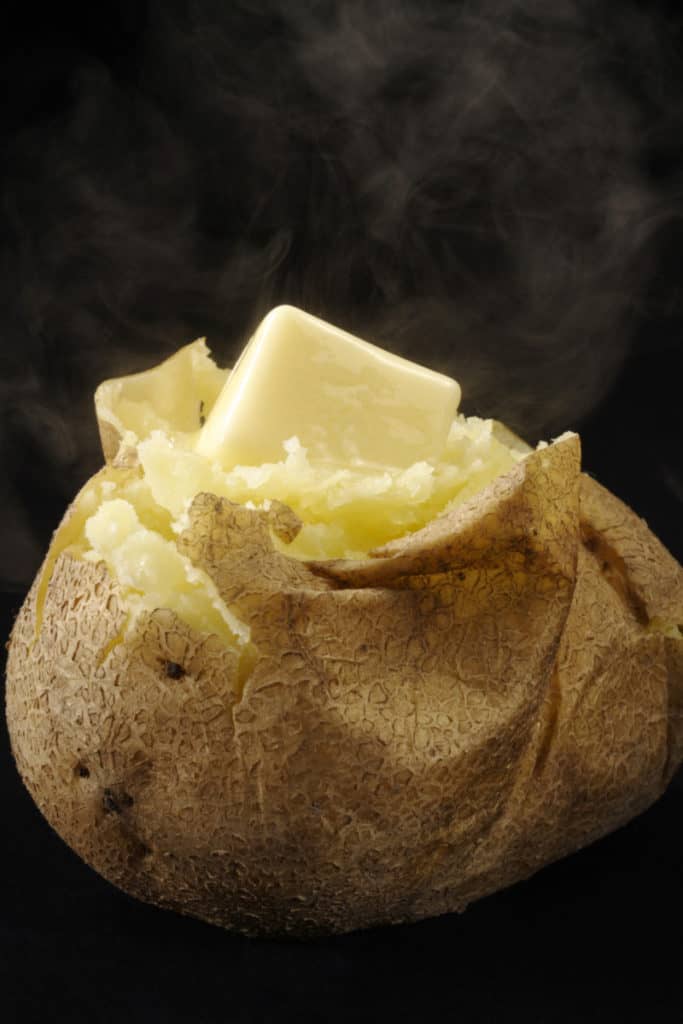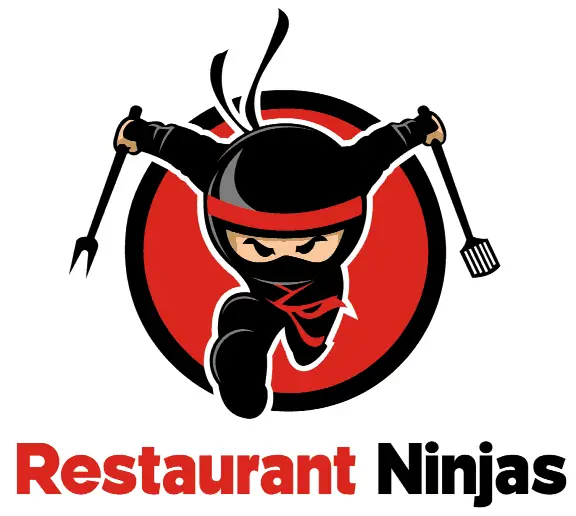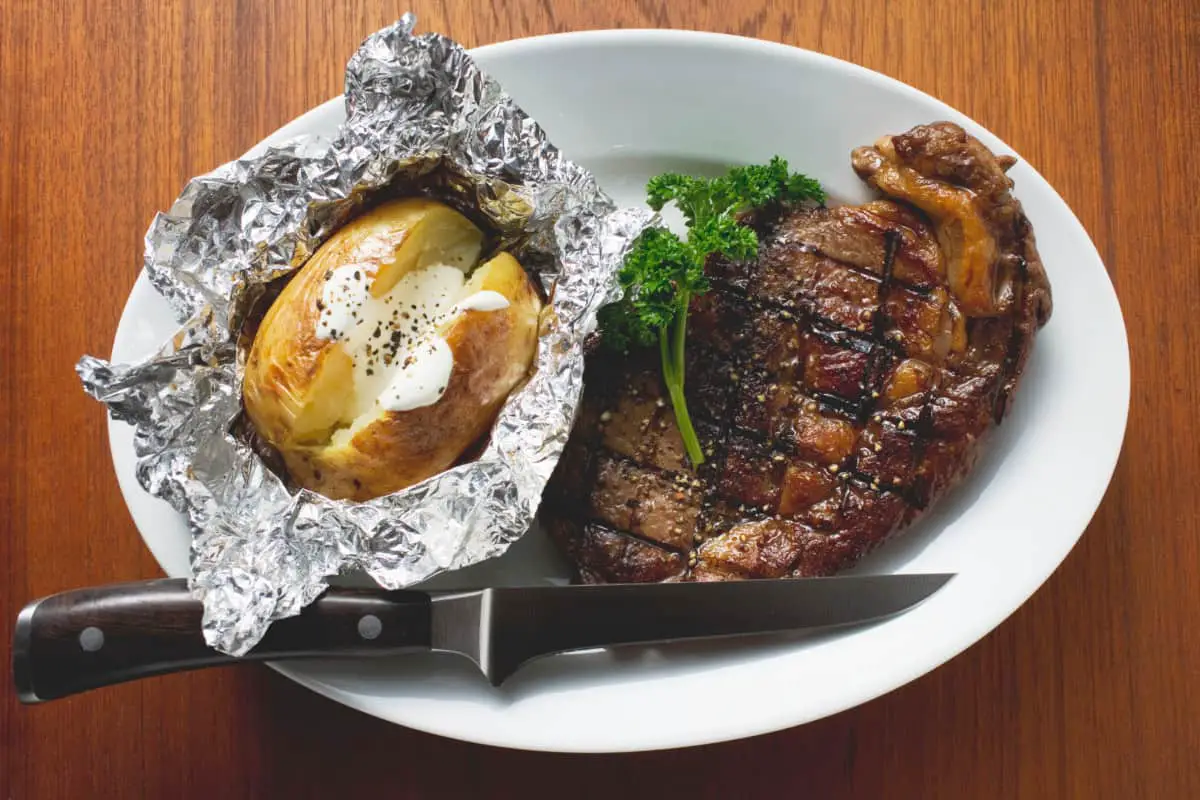Baked Potatoes are a staple at the American dinner table. There really is not anything that compliments a steak or seafood, as well as a baked potato, does. The problem though is that a good baked potato (that isn’t nuked in the microwave) takes time! Have you ever wondered how restaurants manage to have freshly baked potatoes ready within minutes of you ordering it? The secret is in the planning!
How do restaurants make baked potatoes so fast? Restaurants make baked potatoes quickly by baking them in advance and holding them in warming equipment until they are served. They keep the potatoes fresh by rotating out a new round of potatoes regularly to ensure they are always perfect.
Knowing that restaurants have the potatoes in the process of being prepared before you even order them certainly explains the general idea as to how this culinary feat is pulled off. Despite this being a really simple process, I once had a prep cook accidentally mistake oven degreaser for olive oil. Luckily, I caught it before sending any potatoes to a guest (they smelled awful) and went full-on Gordon Ramsey on said prep cook (I believe my exact words were “WHAT DO I PAY YOU FOR!”). Holy cow did I have a temper once, but I digress. The truth is the entire process is pretty simple. Keep reading to understand it from start to finish.
The Restaurant Baked Potato Process (Step by Step)
Like most things in restaurant kitchen operations, having perfectly cooked baked potatoes ready for dinner service starts way in advance. Here is how it gets done, step by step:
1. Determine Potato Needs by Hour
Before the week begins, the Kitchen Manager or Chef determines potato needs by the hour. The best way to do this is to use your kitchen software to run a usage report that shows potatoes sold by the hour. Putting this information into a simple spreadsheet and adding in a buffer (I always use a 50% buffer for potatoes), it is easy to figure out how many potatoes need to cook each hour of operation for each day of the week. If you do not have any type of restaurant software (WHICH YOU SHOULD!), then a good estimate will do.
2. Setup the Potato Rack the Night Before
At the end of each day, a member of the kitchens staff will prepare the “baker rack” for the next day for ease of use. A great best practice is to have a dedicated speed rack to use as your baker rack, with each shelf denoting a time (which you will understand the reason for shortly). Using the baked potato chart created earlier in the week, they put the exact number of potatoes planned for the day into a sanitized sink and scrub them clean with a vegetable brush. Next, set up a sheet pan for each hour of the day with the exact number of potatoes that are needed for the upcoming hour’s orders. For example, if you need 14 potatoes for the 6pm-7pm hour, the “5pm” tray would be set up with 14 potatoes on it.
3. Assign an Employee to “Baker Duty”
“Baker Duty” is an hourly job bestowed upon a member of the kitchen staff. Usually, this is something that falls to a person in a non-service role, such as a prep cook. Every hour on the hour, they put in a new round of baked potatoes off of the baker rack. Before putting them in the oven, the potatoes are coated in olive oil and they are drizzled with kosher salt. A spray bottle works best for the oil application, which should be labeled appropriately. At the same time, they take the previous round out of the oven and move them upfront for service into a warming cabinet. Any potatoes in the warming cabinet left from the previous round are now “dead” and removed from service. They are put into a dated and labeled container in the walk-in cooler. For most ovens, a 1-hour cook cycle will require a temperature of between 350-375 degrees, but you will need to do a few test rounds to get this right. Don’t forget, different parts of the oven are hotter than others despite the entire oven being set to the same temperature.
This cycle starts 1 hour before opening and ends one hour before closing.
4. Serving

When it comes time to serve the potato, it is really simple. Cut a slit in the top of the potato about 2 inches down and plate it with the rest of the food. Before the plate is about to be taken to the table, grab the potato by the ends with your thumb and index finger and squeeze to expose the steaming inside of the potato. Add butter or sour cream, and boom, the perfect baked potato!
What Do they Do with the Leftover Potatoes?

Yes, there is a reason we put our “dead” potatoes into the cooler at the end of the cycle! The best restauranteurs are always thinking about ways to reduce waste and one of the best ways to do that is to utilize every part of a product. In the case of potatoes, there are several things you can do to utilize this waste by creating other menu items that will use it. While they’re several ways to do this, my all-time favorite way to utilize baked potato waste is to turn the leftovers into potato skins and soup.
Potato Skins are one of my all-time favorite comfort foods. Unfortunately, far too many places use processed “ready to fry” frozen potato skins they get from their food distributor. Usually, they are pretty terrible. Instead, use your leftover potatoes from the previous day! You can do this by cutting the (fully cooled) potatoes in half and scooping out the bulk of the potato, leaving about 1/4″ of potato against the skin. Once they are scooped, cut each half into quarters. Freeze and you now have a better version of something most people pay for and it was FREE! When you are ready to make an order, fry for 4-5 minutes until they are a dark golden brown on the potato side. Then add shredded cheese and diced bacon, melt and serve with scallions and sour cream! HEAVEN!
I bet you are wondering how the soup comes into play, aren’t you? Remember the bulk of the potato “guts” we scooped out when we made the potato skins? I like to save that and use it as the base in a soup, once again utilizing waste and cutting down food costs. My go-to soups for the potatoes are clam chowder (both New England and Manhattan) as well as Potato Au Gratin.
There you have it: The key to how restaurants make baked potatoes so fast. Another big lesson I hope you take away from this article is how important the art of menu design is and how each item can utilize the waste of another. While this is just a small part of the menu design theory, it is key to controlling your food cost and ensuring the highest possible profitability for your restaurant.

